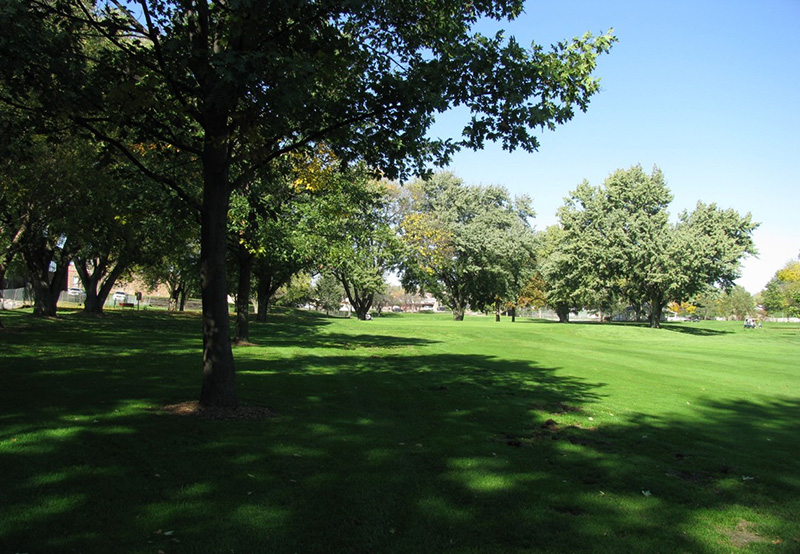
Albert “Al” Dudeck, Ph.D., (1936-2024) was a turfgrass science professor at the University of Florida (Gainesville) from 1970-2002. He earned a doctorate in agronomy at Pennsylvania State University in 1964, under the guidance of turfgrass breeder Joe Duich, Ph.D., (1928-2013). Dudeck was originally from West Hazelton, Pa. Of note, several turfgrass science doctorates are from eastern Pennsylvania, which would make an interesting Verdure article for another time.
Dudeck conducted research on turfgrass establishment and maintenance in low-light conditions. He frequently studied the physiological effects of shade on turfgrass morphology, anatomy, health and function. He related all of this to the influential components of shade: light quantity, light quality and the microenvironment.
With light quality, sunlight reaches Earth’s surface as components of three overall wavelengths (measured in nanometers, nm): ultraviolet light (300-400 nm), visible light (400-700 nm) and infrared light (700-3,000 nm). Photosynthetically active radiation (PAR) is also light in that same 400-700 nm region as visible light and represents light that plants need to fuel their “photosynthesis engine.” PAR varies from month to month, day to day and minute to minute depending on time of year, angle of the sun, day length and cloud cover. Photosynthesis also depends on numerous environmental factors, such as air and soil temperature, plant nutrition, soil water status, age and health of leaf tissues and turfgrass management practices.
With light quality, shade can alter or reduce available light (or PAR) needed for turfgrass growth and development. Overall, when plant nutrition, soil water and air and soil temperature conditions are adequate for plant growth, light is usually the most important growth-limiting factor.
With the microenvironment, shaded sites often have higher relative humidity and extended periods of dew or leaf wetness. This is a favorable environment for diseases. Shade alters the turfgrass’s microenvironment by reducing light quality and quantity, restricts air movement and alters the temperature.
What happens to turfgrasses in shaded or reduced light environments? Typical observations include elongated growth of stems and leaves (i.e., etiolation) that look as if they’re reaching for the sun, reduced density, shortened roots, and thinner and softer leaf tissues, which leads to an overall decrease in health and vigor. Turfgrass in shade is certainly more susceptible to diseases (i.e., rusts, powdery mildews and others), less competitive against weeds and less tolerant of traffic, drought, heat and cold.
One option for managing turfgrass in low-light sites is to utilize shade-tolerant species and cultivars. For example, the fine fescues (Festuca sp.), such as creeping red, Chewings, hard and sheep, are considered the most shade-tolerant turfgrasses. Cultural practices can help, but there’s no product available called “sunshine in a bottle.” With Dudeck’s research on the impacts of shade on turfgrasses, an important theme was: “Increased mowing height increases depth of turfgrass rooting and helps maintain turfgrass density.”
We can’t talk about turfgrass and shade without mentioning trees. Trees can be valuable assets to golf courses, but they also contribute to agronomic, economic, aesthetic and golf playability problems. Trees typically have extensive and shallow root systems that utilize large amounts of soil water and nutrients, and dense foliar canopies that intercept light and restrict light quality and quantity onto the ground below. Don’t forget — tree roots can spread well beyond their canopy. Therefore, tree competition for light, water and nutrients are the three basic causes of turfgrass failure under shaded conditions. Also, poor soil drainage in those shaded areas contributes to poor turfgrass establishment and growth. And poorly drained and shaded sites represent favorable environmental conditions for moss infestation, which adds additional competition for the already weakened turfgrass. As the old saying goes: “Trees grow, and grasses need sun.” Another important saying is: “Plant the right tree in the right location.”
Dudeck contributed a significant amount of research on turfgrasses grown and maintained under shade. Thank you, Dr. Dudeck, for your valuable contributions to turfgrass science.
Source: Dudeck, A.E., and C.H. Peacock. 1992. Shade and turfgrass culture. Turfgrass - Agronomy Monograph No. 32. Eds. D.V. Waddington, R.N. Carrow and R.C. Shearman, ASA-CSSA-SSSA, Madison, Wis. Pages 269-284.
Mike Fidanza, Ph.D., is a professor of plant and soil science in the Division of Science, Berks Campus, at Pennsylvania State University in Reading, Pa. He is a 23-year member of GCSAA.